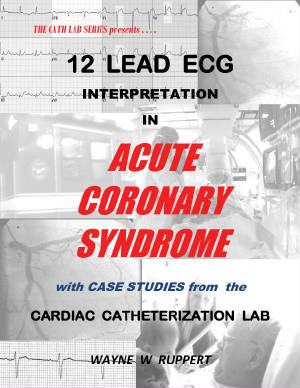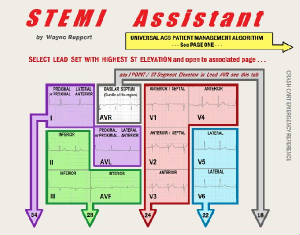|
|
|
 This 304 page full-color textbook,
written and edited by veteran cardiac cath lab interventionalists, is essentially two volumes in one. The first
92 pages present the basic principles of 12 lead ECG interpretation. The remainder of the book focuses on the
evaluation of Acute Coronary Syndrome (ACS) patients. 13 ECG patterns associated with ACS are presented,
including the most subtle ECG changes most often missed by clinicians and the ECG machine’s automated interpretation
software. The curriculum provides an in-depth, balanced approach to patient assessment, combining advanced ECG
interpretation skills with patient history, risk factor and cardiac marker evaluation. Correlation of ECG
leads with the coronary arterial distributions which commonly supply each region of the heart are reinforced by use of 24
case studies of ST Segment Elevation Myocaridal Infarction (STEMI), Non ST Segment Elevation Myocardial Infarction (NSTEMI),
Unstable Angina, and Brugada Syndrome. STEMI Case Studies emphasize the ECG identification of the infarct
related artery, and complications to be expected based on failure of cardiac structures commonly supplied by the obstructed
arterial distribution. Case studies begin with patients' initial assessment data obtained in the emergency department
and continue into the cardiac catheterization lab where coronary artery angiography illustrates the location of arterial obstruction.
Key learning objectives for each type of Myocardial Infarction (MI) are highlighted. 453 full color
images, 135 review questions, and 114 ECGs reinforce the learning process. Target audience is all medical professionals
whom are already competent in single-lead rhythm strip evaluation, and desire to become proficient in the 12 lead ECG evaluation
of Acute Coronary Syndrome patients. This book has been reviewed and recommended by industry leaders in Cardiology,
Emergency Medicine, Nursing and the Emergency Medical Services.
CLICK HERE for STEMI Assistant Information Video
STEMI Assistant is a condensed 42 page reference manual for health care practitioners who care for patients experiencing acute ST Segment Elevation Myocardial Infarction (STEMI). STEMI Assistant presents the latest evidence-based practices as described in the American College of Cardiology (ACC) / American Heart Association (AHA) 2013 STEMI Guidelines, AHA/ACC 2014 Non-ST Elevation (NSTE)-ACS Guidelines and evidence based practices described in 19 additional recent scientific journal articles.
STEMI Assistant is designed to serve as both a classroom textbook and an emergency bedside reference. It is formatted in a sequential, easy to follow order starting with basic definitions of typical and atypical symptoms of Acute Coronary Syndrome (ACS), the latest AHA/ACC/Heart Rhythm Society guidelines for obtaining 12 and 18 Lead ECGs, accurate identification of pre-infarction and STEMI ECG patterns and the identification of STEMI when bundle branch blocks are present.
Model protocols for hospital and pre-hospital practitioners describe the latest evidence based practices for the management of patients with acute chest pain, NSTE-ACS, and STEMI in PCI capable and non-PCI capable scenarios. A generic Emergency Department Physician's STEMI order set reflects the latest AHA/ACC practices for the treatment of STEMI in the ER and satisfies multiple Key Items listed in the Society of Cardiovascular Patient Care's Chest Pain Center accreditation standards.
ACS Risk Stratification is presented, and features the HEART Score. This section of the book was edited by Barbra Backus, MD, PhD, the physician researcher who developed the HEART Score.
Remote Ischemic Conditioning (RIC), an emerging non-invasive procedure proven to reduce myocardial injury from heart attack is introduced, along with a suggested protocol for its application. RIC can be implemented by EMS personnel while enroute to a hospital or in the emergency department prior to cardiac catheterization.
When used as an emergency bedside reference, the book cover features a 12 Lead ECG divided into five color-coded anatomic regions of the heart. Arrows lead from each anatomic region and point to the page number where information specific to each type of STEMI can be found. The information provided advises the clinician of the coronary artery that is most likely occluded, specific complications to anticipate and special considerations that should be observed based on correlations of abnormal ST patterns with common coronary artery anatomy as described in multiple evidence-based publications. CLICK HERE to order STEMI Assistant from Amazon |
